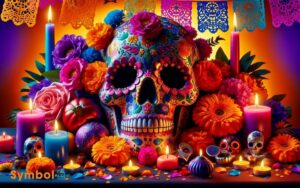Symbolism of the Color Red in the Handmaids Tale: Autonomy!
In “The Handmaid’s Tale,” you’ll find red isn’t just a color; it’s a symbol of contradiction. It represents autonomy and subjugation, fertility alongside the violence endured by the Handmaids.
Wearing red, Handmaids are highly visible, a constant reminder of their role but also their subjection and surveillance. Yet, red also alludes to life and the potential for rebellion within Gilead’s oppressive regime.
This duality of meaning a cloak of visibility that both suppresses and suggests resilience unveils the complex power dynamics at play.
As you explore further, you’ll uncover how red weaves throughout the narrative, highlighting the chilling yet hopeful contrasts Gilead embodies.

Key Takeaways
The Essence of Red
In ‘The Handmaid’s Tale,’ the color red serves as a potent symbol, embodying the complex interplay between fertility, subjugation, and resistance within the narrative.
You’ll notice that handmaids are cloaked in red, a visual manifestation of their roles as both bearers of life and subjects of control. This duality underscores the oppressive mechanisms at play, forcing you to confront the paradox of visibility and invisibility.
Red marks the handmaids as distinct, yet it simultaneously strips them of individuality, reducing their identities to their reproductive functions. It’s a stark reminder of the power dynamics that define their existence.
Through this lens, red isn’t just a color; it’s a narrative device that intricately weaves themes of autonomy, identity, and the struggle for self-determination.
Fertility and Blood
Building on the idea of red as a symbol of both fertility and subjugation, it’s important to recognize how the color also embodies the motif of blood, a fundamental element representing life and the potential for rebirth within the oppressive confines of Gilead.
This dual symbolism isn’t coincidental but rather meticulously chosen to reflect the paradoxical nature of the Handmaids‘ existence.
You’re witnessing a society that idolizes fertility and the birthing of children as sacred, yet simultaneously subjects these very bearers of life to relentless control and subjugation.
The red they wear isn’t just a marker of their role; it’s a constant reminder of the blood that signifies both their potential to give life and the violence they endure. Consequently, red becomes a powerful emblem of the life-giving yet oppressive reality of Gilead.
Red: A Cloak of Visibility
While the color red shrouds the Handmaids in a mantle of fertility and blood, it also paradoxically singles them out, making their presence unmistakably visible in the drab backdrop of Gilead’s society. This visibility isn’t merely physical; it’s laden with societal implications.
You see, by being so conspicuously marked, the Handmaids are constantly under surveillance, their every move watched and judged. This visibility serves as a double-edged sword: it both protects and oppresses.
It shields them under the guise of importance and sanctity due to their reproductive roles, yet simultaneously subjects them to the panoptic gaze of Gilead’s authoritarian regime.
Consequently, the red cloak becomes a symbol not just of fertility, but of the intense scrutiny and control exerted over the Handmaids.
Power Dynamics Unveiled
The color red in ‘The Handmaid’s Tale’ not only signifies fertility and blood but also unravels complex power dynamics, revealing the stark hierarchies that govern Gilead’s society.
Through its vividness, red becomes a tool for illustrating control:
- Visibility vs. Invisibility: Red cloaks make the handmaids highly visible, yet simultaneously erase their individuality, emphasizing their role as state-owned fertility vessels.
- Distinction: The color sets handmaids apart, underscoring their unique, albeit oppressed, status within the social order.
- Authority: Commanders and their wives wield power, with the wives’ blue attire starkly contrasting the handmaids’ red, symbolizing a chilling dichotomy of power.
- Resistance: Despite its intended symbolism, red also becomes a beacon of resistance, rallying handmaids together against their oppressors, subtly shifting power dynamics.
Subjugation and Uniformity
You’ll find that in ‘The Handmaid’s Tale,’ the red dresses worn by the Handmaids serve as a poignant symbol of both subjugation and uniformity.
This vivid color marks them as property, stripping away individuality and reducing their identities to mere functions within the regime.
Moreover, it acts as a visual control mechanism, constantly reminding both the wearers and the onlookers of the oppressive power structure at play.
Red Dresses Significance
In Margaret Atwood’s ‘The Handmaid’s Tale,’ red dresses serve as a potent symbol of both the subjugation and enforced uniformity experienced by the Handmaids. These garments aren’t merely clothing but a complex signifier within the dystopian world of Gilead.
- Visibility and Vulnerability: The red color makes Handmaids highly visible, emphasizing their role and status.
- Fertility and Blood: Red symbolizes fertility, a central theme, as well as the violence they endure.
- Loss of Individuality: The uniformity of the red dresses erases personal identity, reducing Handmaids to their reproductive function.
- Historical Oppression: The color evokes historical symbols of female oppression and martyrdom, adding depth to their plight.
Understanding these layers enriches our grasp of the narrative’s critique on control and resistance.
Visual Control Mechanism
Leveraging a sophisticated visual control mechanism, Gilead’s regime enforces subjugation and uniformity among the Handmaids through their mandated attire, stripping them of individuality and autonomy.
This strategic choice of red not only marks them as bearers of children but also embeds a deep-seated mechanism of control.
It’s a constant reminder of their role and status, visible to all, making any form of dissent not just rebellion against the state but a visible, stark contrast to the sea of red. This uniformity eradicates personal identity, reducing each woman to a function rather than an individual.
It’s a visually enforced hierarchy, where color delineates power, or the lack thereof, and solidifies the Handmaids’ position at the lower echelons of Gilead’s societal structure.
Resistance and Rebellion
You’ll find that the color red’s dual nature in The Handmaid’s Tale embodies not only subjugation but also a whisper of resistance and rebellion.
While uniforms intended to suppress individuality inadvertently ignite defiance among the handmaids, these garments become symbols of their unspoken unity against oppression.
Furthermore, symbolic acts of rebellion, subtle yet profound, underscore the transformative power of red as a beacon of hope amidst despair.
Reds Dual Nature
Amidst the oppressive regime of Gilead, the color red embodies a paradox, serving as both a symbol of subjugation and a beacon of resistance and rebellion.
This dual nature is evident in how characters interact with and perceive the color:
- Subjugation: Red marks the Handmaids as property, stripped of individuality and autonomy.
- Visibility: Despite its intent to shame, the vividness of red makes Handmaids conspicuously present, challenging the regime’s narrative.
- Unity: The shared color becomes a silent pact among Handmaids, signaling a collective identity that transcends their imposed roles.
- Rebellion: Red evolves into a symbol of their unspoken resilience and defiance against Gilead’s tyranny.
Understanding this duality enriches your grasp of the narrative’s complexities and the subtle acts of rebellion woven throughout.
Uniforms Ignite Defiance
In the stark landscape of Gilead, the Handmaids’ uniforms, vibrant in red, emerge not just as markers of oppression but as catalysts for defiance and symbols of resistance. This transformation isn’t coincidental but a tribute to the human spirit’s resilience.
| Aspect | Impact |
|---|---|
| Color Red | Embodies both captivity and courage. |
| Uniformity | Sparks individual rebellion. |
| Visibility | Guarantees acts of defiance are observed. |
| Symbolism | Transforms a tool of control into a beacon of hope. |
| Collectivity | Fosters a sense of solidarity among the oppressed. |
Through these uniforms, you witness a paradoxical shift: what’s meant to suppress becomes a source of empowerment.
The red attire, initially a chain, evolves into a declaration of dissent, underscoring the profound power of symbols in fueling resistance and rebellion.
Symbolic Acts of Rebellion
Throughout ‘The Handmaid’s Tale,’ characters engage in various symbolic acts of rebellion that challenge the oppressive regime of Gilead, subtly undermining its authority from within.
These acts serve not only as individual expressions of defiance but also as beacons of hope and solidarity among the oppressed.
Consider the following symbolic gestures:
- Wearing forbidden items subtly asserts individuality and resistance.
- Secret literacy practices challenge Gilead’s control over knowledge and information.
- Covert exchanges of names preserve personal identity and history, defying the regime’s attempt to erase individuality.
- Silent complicity and non-verbal communication among handmaids foster a sense of community and collective resistance.
These acts, though small, are potent symbols of resistance, illustrating how even in the most oppressive circumstances, the human spirit fights for freedom and autonomy.
Identity and Individuality
Margaret Atwood’s choice of red for the Handmaids’ attire symbolically strips them of their individuality, reducing their identities to a singular, communal role within Gilead’s dystopian society.
This uniformity enforces a collective identity, erasing personal histories, desires, and attributes under the guise of piety and utility.
It’s a visual manifestation of control, illustrating how the regime views Handmaids: mere vessels for reproduction, devoid of personal agency or identity. Yet, within this imposed homogeneity, Atwood subtly embeds the potential for resistance.
The color red, traditionally symbolizing passion, power, and defiance, offers a paradoxical glimpse of the suppressed individuality and resilience within each Handmaid.
Their forced sameness becomes a site of silent rebellion, hinting at the indomitable spirit that lies beneath the surface.
Cultural and Historical Context
Delving into the cultural and historical context, it’s evident that the color red carries profound implications, resonating with themes of power, fertility, and sacrifice across various societies and epochs.
This color’s symbolism is deeply ingrained in our collective psyche, underscoring its significance in ‘The Handmaid’s Tale’:
- Power: Red has long been associated with royalty and authority, suggesting the Handmaids’ paradoxical position of both subjugation and importance.
- Fertility: Its connection to blood and life-giving forces highlights the Handmaids’ central role in reproduction.
- Sacrifice: Reflects the Handmaids’ continuous loss and suffering for society’s greater good.
- Warning: Historically used to signal danger, red underscores the perilous nature of Gilead’s regime.
Through this lens, red becomes a multifaceted symbol, enriching the narrative with layers of meaning that transcend the literal.
Red in Gileads Landscape
Having explored the complex symbolism of red in cultural and historical contexts, we now turn our attention to how this potent color saturates Gilead’s landscape, further embedding its significance within the narrative fabric of ‘The Handmaid’s Tale’.
In Gilead, red isn’t merely a hue; it’s a vivid declaration of control and status. The Handmaids’ red cloaks act as a glaring contrast against the stark, oppressive environment, signaling their roles as both bearers of life and prisoners of a theocratic regime.
This omnipresence of red transcends mere aesthetics, serving as a constant reminder of the handmaids’ subjugation and the pervasiveness of Gilead’s authoritative grip.
It’s a visual motif that reinforces the chilling reality of their existence, making red not just a color, but a symbol of power, warning, and resistance within this dystopian world.
Symbolic Contrasts and Comparisons
You’ll find that in ‘The Handmaid’s Tale,’ the color red serves as a poignant lens through which power dynamics, the juxtaposition of oppression versus freedom, and the nuances of fertility symbolism are vividly explored.
This hue not only marks the handmaids as bearers of potential life but also as prisoners within Gilead’s rigid societal structure, highlighting a complex interplay between visibility and subjugation.
Through these symbolic contrasts and comparisons, the narrative intricately weaves a tapestry that challenges you to reconsider notions of control, autonomy, and the human condition itself.
Power Dynamics Depicted
In ‘The Handmaid’s Tale,’ the color red serves as a complex symbol, intricately woven into the fabric of power dynamics, revealing stark contrasts and comparisons between characters and their societal roles.
You’ll find that red not only binds the Handmaids to their roles but also sets them apart, highlighting:
- The visibility and vulnerability of the Handmaids, marked for all to see.
- The contrast with the Wives’ blue, signifying a cold, sterile authority versus the Handmaids’ forced fertility.
- The illusion of power it gives Handmaids, a deceptive empowerment.
- The blood symbolism, representing both life and death, underlining the brutal reality of their existence.
Through these elements, red underscores the complex interplay of power, submission, and rebellion, painting a vivid portrait of control and resistance within the narrative.
Oppression Vs. Freedom
Building on the vivid imagery of power dynamics, the color red in ‘The Handmaid’s Tale’ also opens a window into the stark dichotomy between oppression and freedom.
This hue, donned by the handmaids, symbolizes their systemic subjugation, marking them as vessels of reproduction, devoid of autonomy.
Yet, paradoxically, red also whispers of rebellion and the fierce spirit of those fighting for their liberation. It embodies the blood of childbirth, yes, but also of defiance, of wounds inflicted in silent resistance.
The color becomes a complex emblem, where oppression is interwoven with the potential for freedom. It’s a visual reminder that within the confines of control, the seeds of revolution can sprout, challenging the very structures that seek to restrain.
Fertility Symbolism Explored
Delving deeper into the symbolic terrain of ‘The Handmaid’s Tale,’ the color red not only marks the handmaids as symbols of oppression but also vividly encapsulates fertility’s dual essence—life’s genesis and the potential for its defiance.
- Life and Blood: Red symbolizes the blood of childbirth, the primary function of the handmaids.
- Menstruation: Its absence signals successful conception, while its presence is a stark reminder of failure in the society’s eyes.
- Passion and Danger: The color evokes both the passion of creation and the danger inherent in the act of conception under duress.
- Fertility and Sacrifice: Red represents the fertility demanded by the regime, yet simultaneously, the sacrifice of personal autonomy and identity.
This complex interplay underscores the thematic richness of Atwood’s narrative, inviting a deeper contemplation of fertility’s portrayal in dystopian literature.
Hope Amidst Despair
Amidst the oppressive sea of red that defines the Handmaid’s existence, glimmers of hope persist, subtly challenging the despair that permeates their world.
This vibrant hue, while initially symbolizing control and subjugation, paradoxically embodies a dual message of resistance and resilience.
You see, the red garb, beyond its intended purpose of marking and muting, inadvertently becomes a beacon of solidarity among the Handmaids.
Through shared glances, whispered words, and covert meetings, the color red transforms into a symbol of their undying spirit and mutual support.
It’s a validation of human resilience, where even in the bleakest of circumstances, the human spirit finds ways to signify hope.
This layered interpretation invites you to appreciate the complexity of symbolism, where color transcends its visual impact to convey profound messages of human endurance and optimism.
The Colors Narrative Impact
Having explored the duality of the color red as both a symbol of oppression and a beacon of hope, we now turn our attention to how color, more broadly, shapes the narrative landscape of ‘The Handmaid’s Tale’.
- Blue: Represents the Commanders’ wives, embodying power, control, and the coldness of the regime.
- Green: Worn by the Marthas, symbolizes their role in nurturing and maintaining life, albeit under subjugation.
- White: Signifies purity and innocence, often seen in the attire of young girls, highlighting the regime’s manipulation of innocence.
- Black: Associated with the Eyes, it evokes fear, authority, and the omnipresence of surveillance.
Through these colors, the narrative weaves a complex tapestry, reflecting the characters’ identities, roles, and the oppressive hierarchy of Gilead, offering a profound commentary on resistance and conformity.
Conclusion
In the tapestry of ‘The Handmaid’s Tale,’ the color red weaves a vivid thread of meaning, binding the story’s themes with a visceral intensity. It’s the scarlet letter of fertility worn unwillingly, a beacon of subjugation, yet paradoxically, a mantle of resistance.
Through Gilead’s monochrome lens, red bleeds a narrative of power, oppression, and the flickering flame of hope. In this dystopian canvas, red not only marks the handmaids but underscores the resilience of the human spirit against the backdrop of despair.






